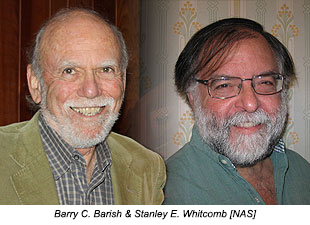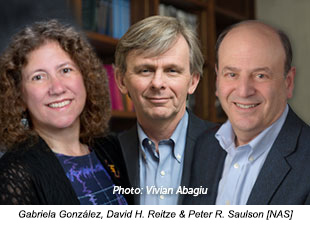National Academy of Sciences Honors LIGO Researchers

Richard Fienberg Running Hare Observatory
Adapted from a National Academy of Sciences press release:
The National Academy of Sciences will honor five astrophysicists with awards in recognition of their extraordinary scientific achievements in gravitational-wave astronomy.
Barry C. Barish, Linde Professor of Physics Emeritus at California Institute of Technology, and Stanley E. Whitcomb, LIGO Laboratory Chief Scientist at California Institute of Technology, will receive the 2017 Henry Draper Medal.
Together, Barish and Whitcomb led the large and talented team that built the Laser Interferometer Gravitational-Wave Observatory (LIGO). LIGO's twin 4-kilometer-long detectors, in Louisiana and Washington, made the 2015 discovery of gravitational waves from colliding black holes, directly validating Einstein's 100-year-old prediction of gravitational waves and ushering in a new field of gravitational-wave astronomy.
Barish joined LIGO at a crucial time in 1994. As LIGO director, his experience with large, high-energy physics experiments made him uniquely suited to balance conflicting needs as the scientifically challenging tabletop-scale project grew to a robust multi-kilometer experimental facility. He conceived and created two related entities: the LIGO Laboratory, which managed, designed, built, operated, and maintained the LIGO instruments while carrying out needed research; and the LIGO Scientific Collaboration (LSC), which expanded the research team by drawing in more than 1,000 researchers from around the world, thereby enabling the project's success.
Whitcomb joined the gravitational-wave effort in 1980 and participated in the early experimental work that proved the feasibility of making such precise measurements. He led the team within the LIGO Laboratory that designed and commissioned the first generation full-scale LIGO detectors. At one point or another, he was involved in virtually every aspect of LIGO's work. Along the way, he helped train the team of scientists and engineers that designed and built the Advanced LIGO detectors that eventually made this historic detection.
The Henry Draper Medal is awarded every four years and is presented with a $25,000 prize. The medal honors a recent, original investigation in astronomical physics of importance and benefit to science to merit such recognition.
Gabriela González, professor of physics and astronomy at Louisiana State University; David H. Reitze, executive director, LIGO Laboratory at California Institute of Technology and professor of physics at the University of Florida; and Peter R. Saulson, Martin A. Pomerantz '37 Professor of Physics at Syracuse University, will receive the 2017 NAS Award for Scientific Discovery.
Saulson served as the first elected spokesperson for the LIGO Scientific Collaboration (LSC), filling a role first established by physics pioneer and LIGO co-founder Rainer "Rai" Weiss. Reitze and González succeeded him in this effort, which involves the work of 90 institutions and more than 1,000 researchers around the globe. Since its establishment in 1997, the LSC spokesperson has led the organization that established and carried out the scientific program of LIGO.
The efforts of their combined 19 years of leadership paid off, when the LSC announced that it had observed the gravitational waves from two colliding black holes, a collision that caused ripples in spacetime that could be measured on Earth. The observation, hailed as one of the most important scientific discoveries of 2015, proved the existence and properties of gravitational waves first predicted by Einstein in his general theory of relativity a century earlier and capped a 60-year experimental quest involving thousands of researchers from around the world. More importantly, the detection of gravitational waves passing through Earth on 14 September 2015, and then again on 26 December 2015, started a new field of gravitational-wave astronomy.
The NAS Award for Scientific Discovery is presented every two years to recognize an accomplishment or discovery in basic research, achieved within the previous five years, that is expected to have a significant impact on one or more of the following fields: astronomy, biochemistry, biophysics, chemistry, materials science, or physics. The award rotates among these fields as determined by the NAS Council. To be eligible for an award, a candidate must be a scientist at a university, college, or other research institution within the United States. The award was endowed in 2014 in honor of John P. Schaefer through a gift from Research Corporation for Science Advancement (RCSA) and the Frederick Gardner Cottrell Foundation. This award is presented with a medal, a $50,000 cash prize, and $50,000 to support the recipients' research.
The winners will be honored in a ceremony on Sunday, 30 April, during the National Academy of Sciences' 154th annual meeting.
The National Academy of Sciences is a private, nonprofit institution that was established under a congressional charter signed by President Abraham Lincoln in 1863. It recognizes achievement in science by election to membership, and — with the National Academy of Engineering and the National Academy of Medicine — provides science, engineering, and health policy advice to the federal government and other organizations.



